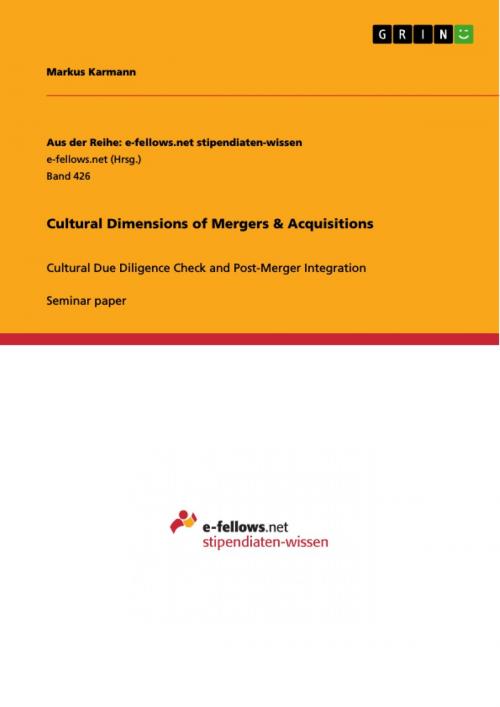Cultural Dimensions of Mergers & Acquisitions
Cultural Due Diligence Check and Post-Merger Integration
Business & Finance, Management & Leadership, Management| Author: | Markus Karmann | ISBN: | 9783656189091 |
| Publisher: | GRIN Verlag | Publication: | May 11, 2012 |
| Imprint: | GRIN Verlag | Language: | English |
| Author: | Markus Karmann |
| ISBN: | 9783656189091 |
| Publisher: | GRIN Verlag |
| Publication: | May 11, 2012 |
| Imprint: | GRIN Verlag |
| Language: | English |
Seminar paper from the year 2011 in the subject Business economics - Business Management, Corporate Governance, grade: 1,0, Northeastern University of Boston, course: Cultural aspects in International Business, language: English, abstract: Over the past several decades, the global economy has become increasingly intertwined as emerging markets continue to grow. Trade barriers have been broken by free trade agreements and the creation of the World Trade Organization while advancements in technology have allowed for the instantaneous transmission of information across the world. In order to expand operations, companies are increasingly looking towards mergers and acquisitions to grow operations internationally. Over the past 10 years, there have been over 251,000 global merger and acquisition transactions valued at $23 trillion US dollars (Exhibit A). While the recent downturn in the global economy has seen transactions decline from a peak of over $4 trillion dollars in 2007 to $2.19 trillion in 2010, M&A activity is expected to rebound given high cash levels and strong fundamental support for M&A , stronger growth levels in emerging markets and a desire for international acquisitions in order to 'mitigate the risks of expanding in the global market.' While there is a strong demand to expand in the global market and technological advancements have allowed for ease of evaluating a potential M&A opportunity, there remains a wide cultural gap that one must understand and bridge in order to be successful. In this paper, we describe the phases of the merger process and show important factors that must be examined. We will not only focus on the cultural dimensions of Hofstede and other tools learned in class but also analyse the importance of premerger cultural due diligence and the post-merger integration process. Our extensive research on the post and pre-merger process is complemented by our examination of ASG, a company that has conducted numerous acquisitions over the past 20 years. The company is a software company founded in 1986. Our examination of ASG shows the ability of successfully evaluating the culture of the organization in the pre-merger process and furthermore, ASG's ability to successfully integrate the acquisition.
Seminar paper from the year 2011 in the subject Business economics - Business Management, Corporate Governance, grade: 1,0, Northeastern University of Boston, course: Cultural aspects in International Business, language: English, abstract: Over the past several decades, the global economy has become increasingly intertwined as emerging markets continue to grow. Trade barriers have been broken by free trade agreements and the creation of the World Trade Organization while advancements in technology have allowed for the instantaneous transmission of information across the world. In order to expand operations, companies are increasingly looking towards mergers and acquisitions to grow operations internationally. Over the past 10 years, there have been over 251,000 global merger and acquisition transactions valued at $23 trillion US dollars (Exhibit A). While the recent downturn in the global economy has seen transactions decline from a peak of over $4 trillion dollars in 2007 to $2.19 trillion in 2010, M&A activity is expected to rebound given high cash levels and strong fundamental support for M&A , stronger growth levels in emerging markets and a desire for international acquisitions in order to 'mitigate the risks of expanding in the global market.' While there is a strong demand to expand in the global market and technological advancements have allowed for ease of evaluating a potential M&A opportunity, there remains a wide cultural gap that one must understand and bridge in order to be successful. In this paper, we describe the phases of the merger process and show important factors that must be examined. We will not only focus on the cultural dimensions of Hofstede and other tools learned in class but also analyse the importance of premerger cultural due diligence and the post-merger integration process. Our extensive research on the post and pre-merger process is complemented by our examination of ASG, a company that has conducted numerous acquisitions over the past 20 years. The company is a software company founded in 1986. Our examination of ASG shows the ability of successfully evaluating the culture of the organization in the pre-merger process and furthermore, ASG's ability to successfully integrate the acquisition.















